#filipino food history
Text
the thing about being from a place whose written history only began with colonialism is that it's like. i know you. i love you. you're in my very bones. but at the same time: who are you? who are you? who are you?
#route66#this is the difference btwn my filipino ancestry and indian ancestry#bc there's lots of rich documented indian history in writing & architecture & religion & food even if the british stole a fuckton of it#but the philippines is like. literally what was going on!!!!!! what was happening!!! tell me#but unearthing pre-colonial filipino history is essentially an archeological event
17 notes
·
View notes
Text
Simbang Gabi: The 9 Days Before Christmas

An image of a red parol from Peakpx.com
The Philippines is well-known for its extremely long Christmas celebration that a lot of foreigners often look at with confusion. Traditionally, Filipinos may start putting up their trees, playing festive songs, and counting down to the 25th as early as September in a season that's colloquially called the "ber months" or the "ber months season" (Petrelli, 2021). This period often lasts up until January or February where some houses may still keep their trees and decor pushing as far as March.
Even with this technicality, however, you'd be hard-pressed to find Filipinos truly celebrating from the very beginning of September genuinely ending it by the end of February. Most often, actual celebrations start after Undas, a period encompassing All Saints' Day and All Souls' Day on the 1st and 2nd of November respectively to commemorate the dead, similar but a lot more subtle than other Catholic countries own Day of the Dead like in Mexico's Dia de Los Muertos and Italy's Giorno dei Morti. This time period is often the start of people doing more Christmas-y things such as Kris Kringle activities leading up to the main Christmas party.
The main markers of the true start in itself is the Advent season, which starts on the Sunday nearest to the 30th in Western Churches like Roman Catholicism and leads up to Christmas ("Advent", n.d.). This is where Catholics would go to Church every Sunday leading up to Christmas to light the Advent Wreath until the final candle on its center on Christmas day on the 25th. As the Philippines is heavily influenced by Roman Catholicism, Filipinos follow the Western start of Advent and most celebrations often fall in the middle of this time period. Even the middle of Advent, however, Filipinos have a waiting period to count down before Christmas - Simbang Gabi.
What is Simbang Gabi?
Simbang Gabi (en. night mass; going to mass at night) is a Philippine Christmas tradition wherein Roman Catholic Filipinos would attend mass nine days every single morning or night before the actual Christmas celebration. Traditionally, the masses were held every morning at 4:00 AM from the 16th to the 24th which would then be capped off by Christmas Eve Mass at night or Christmas Mass on the 25th with its early schedule earning it the name Misa de Gallo (en. mass of the rooster) (Lazaro, 2020). In most dioceses, however, they often have an anticipated mass schedule that start a night earlier than the morning masses (Hermoso, 2022).
Besides being called Misa de Gallo, I had also heard the celebration being called Misa de Aguinaldo (en. mass of gifts) in some places. This shares the same name as the similar Puerto Rican tradition Misa de Aguinaldo which is also a nine-day mass held in the morning, typically at 5:00 AM which is also deeply-rooted in Puerto Rican Christmas traditions (Álvarez, 2018).
History
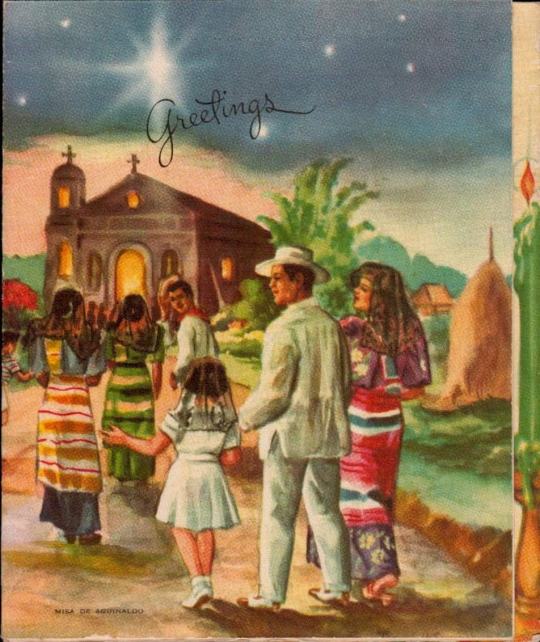
A vintage greeting card posted by the Facebook group Vintage Philippine Islands 1920-1959 (2020)
Being a Christmas tradition, it is not surprising that Simbang Gabi could trace itself back to the Spanish colonial period.
A common misconception of its origins states that the practice first started in Mexico. Hermoso (2018) states that it started on the year 1587 by Friar Diego de Soria of the Convent of San Agustin Acolman when he requested the Vatican to allow church service to be held outdoors because of an overflow of attendees during the Christmas time. Pope Sixtus V later approved of this request and even decreed that these kinds of masses be held in the Philippines at the dawn of the 16th of December. What this doesn't account for was that the practice of going to church for the Eve of Christmas dates back to even earlier than the 16th century.

The cover for an English translation and compilation of Etheria's writings by M.L. McClure and C.L. Feltoe, D.D. (1919)
The first recorded instance of Christians celebrating Christmas by going to early mass leading up to the actual date was first written by Egeria (also called Egeriae, Etheria, or Aetheria), a Christian Galician woman who first recorded it during her travels to the Levant where she notes the early morning masses and festivities from the time of the Epiphany to the Nativity. She writes in her letters later called the Itinerarium Egeriae (en. The Travel Guide of Egeria; The Pilgrimage of Etheria).
"Octave of the Festival.
On the second day also they proceed in like manner to the church in Golgotha, and also on the third day; thus the feast is celebrated with all this joyfulness for three days up to the sixth hour in the church built by Constantine (...) And in Bethlehem also throughout the entire eight days the feast is celebrated with similar festal array and joyfulness daily by the priests and by all the clergy there, and by the monks who are appointed in that place (...) and immense crowds, not of monks only, but also of the laity, both men and women, flock together to Jerusalem from every quarter for the solemn and joyous observance of that day."
- Egeria, 381-384; The Pilgrimage of Etheria (trans. McClure & Feltoe, 1919):
The practice of attending early morning masses up until the main festivities of the Nativity was later adopted by more Western Christian communties during the time of Pope Sixtus III when he celebrated what is widely considered the first Midnight Mass at the Basilica of St. Mary Major in Rome, not only stemming from the popularity of the Christians from Jerusalem but also the popular belief that Jesus was born at midnight (The Pillar, 2021).
The prayer spoken within the midnight vigil was then called the "mox ut gallus cantaverit" which translates to "when the rooster crows", aptly named because of the early hours the vigil tended to last which then coincided with the crowing of roosters ("Misa del Gallo: origen, historia y por qué se celebra en la madrugada del 25 de diciembre", 2022). The practice was continued by the Spanish with the name Misa de Gallo (also called Misa de Aguinaldo)which later spread throughout the Spanish Empire and could now be seen practiced in countries like Bolivia, Puerto Rico, Venezuela, and of course the Philippines.
There seem to be two variations of this: the nine-day series of masses before Christmas (found in the Philippines, Puerto Rico, and Venezuela) and the single early morning mass before Christmas day (found in Spain and Bolivia). It isn't clear if Spain and Bolivia simply dropped the nine-day tradition or if the nine-day tradition was restarted in these other colonies, however.
In the Present Day

An image of crowds outside a church during Simbang Gabi uploaded to Wikimedia by Erwin Malicdem
Today, the Simbang Gabi continues to be a popular tradtion for most Filipino Roman Catholics, even those who aren't typically as religious most parts of the year. This is given the fact that a popular belief is that when a person completes all of the nine days, they may receive a wish to whatever they desire. This is such a common belief that Bishop Broderick Pabillo, a Manila auxiliary bishop, had to remind people that the point of the tradition is to remember Jesus and his nativity (Punay, 2016). Besides this, it is also a common challenge among Filipinos to try to complete it as is or see how many days out of the nine could they actually attend.
It is not uncommon for churches these days to hold an "anticipated" mass the night before the actual date starting instead on the 15th and ending on the 24th with a Christmas mass, instead of starting on the 16th and ending on the 25th. This newer tradition had come from the reign of Filipino dictator President Ferdinand Marcos Sr. during the Martial Law years in the 70s, when Filipinos were not allowed to go out after a curfew until 4 in the morning (Macairan, 2023). This allowed more people and especially those who may not be able to start their day early or those who may have other obligations in the morning to attend masses at night time, typically at around 6 PM - 8 PM.
The only large controversy that I could remember about Simbang Gabi was back in 2011 when the event was banned from being conducted within the Philippine Center in New York City. The ban came about because of it supposedly violated Canon Law which prohibits religious worship in unconsecrated ground or in other words places that aren't seen as places of worship. In an article by Adarlo & Pastor (2014), Rev. Dr. Joseph G. Marabe, the at-the-time head of the Chapel of San Lorenzo Ruiz and a priest-in-residence at St. Patrick's Cathedral where the ban took place, explains in an interview with news site The FilAm:
"It’s not allowed by law to have Holy Mass in an unconsecrated place. Worship should take place in a sacred place. That was an explanation but not a decision. The Archdiocese decides."
- Rev. Dr. Joseph G. Marabe, head of the Chapel of San Lorenzo Ruiz in Chinatown, New York (2011)
The ban was later lifted on 2014 after community leader Loida Nicolas Lewis wrote a letter to the diocese to reconsider the ban which led to the return of the almost 30-year-old tradition that year (Balitang America, ABS-CBN North America Bureau, 2014).
Besides being a huge part of current traditions, a lot of Filipinos, and especially Filipino youth, use the event as an excuse to go out during the night to hang out with friends and even go on dates with their partners. It is not an uncommon sight to see a group of teenagers, often wearing maybe less than typical church clothes, by the edge of the Church seemingly attending mass. Whether or not they're actually being attentive is hard to decipher. Either way, this has led to an explosion of memes almost every year just mocking these kinds of people or making fun of their own.

A screenshot of the "Simbang gabi starter pack" posted by user rhapido on 9Gag.com (2022)
Earlier versions of this meme could be seen posted throughout Filipino social media during the early 2010s

A meme posted by the Facebook page FEU Memes (2012)
The barkada (en. friend group) going to Simbang Gabi had been an older tradition that has found a lot more popularity in the contemporary era because of social media. My mother had told me that she used to use it as an excuse herself back in the 80s to hang out with her friends at night time. This may be a continued past time for especially younger people for years to come.
There's also many street foods associated with Simbang Gabi that may not be unique to the event itself but are nevertheless heavily associated with the event due to their widespread sale during this time period. Foods like bibingka, puto bumbong, kutsinta, and other popular rice cakes dominate the scene which definitely satisfy the hungry parishioners who had, most likely, not eaten breakfast or dinner before going to church. With their strong associations with Simbang Gabii and Filipino Christmas as a whole, I might discuss these on a later date.
Simbang Gabi, from my experience
Growing up and living in the Philippines and especially being raised Catholic within a Catholic town named after a Catholic saint and going to a Catholic school named after another Catholic saint, it probably won't shock you that I, myself, had tried to complete the nine days of Simbang Gabi myself. I had attempted it several times with only maybe trying seriously by myself once in my life. It was quite the experience to just try to dedicate yourself into completing a goal to do something for nine consecutive days straight.
My first attempt was when I was in Junior High and it was with my sister and two people who worked for my parents and had helped watch over us. It was something that I always wanted to try doing and especially since I was gaining a lot more independence at the time so what better to try it out without the rest of the family? With adult supervision, of course.
Since we lived quite away from the actual church, the place was already packed even an hour before the actual mass started. There was barely any seats left and even less standing room leading to a huge overflow of people stuck outdoors, only hearing mass from the outdated speaker system that they had erected in place of the old bell tower.
The mass in our church was often done in the dark during the night out of an deliberate and probably aesthetic choice with only the alter being illuminated by the lights. The rest was lit up by the scattered about Christmas decor throughout the church and the church patio. It always felt like going to some liminal space that other nights at church just doesn't give.
Once the mass has been concluded, people rush out of the doors in thick crowds to find their way into the footpaths leading on to the main town streets. Some opt to stay behind to enjoy the food stalls that had pop-up for the night to eat bibingka, puto, sapin-sapin, and palitaw among other things. Some of the teens had decided to raid the nearby small park and playground as a hang-out spot to talk the night away before they rush home for their curfews. Meanwhile others were just rushing to get home as soon as they can, with people lining up to go to the rudimentary parking space that the church created while the others who didn't own their own vehicles forced to compete for the very few commuter vehicles still riding through the night, hunting for passengers.
This was before we had our own car, so we were with the latter crowds of people, trying to peer through the dark streets only illuminated by the scant Christmas lights that still refused to turn off as the night progressed. Every so often, two headlights excite the crowd and a swarm of them start running in anticipation with not care or tact if they would crush children or separate families all to take a seat on the night jeepneys, some the few commutes left after 9.
My sister was an expert in finding her way through it, reaching out to the doors to form a barricade for herself and the rest of us to prevent others from taking our seats before letting herself in. I still think I would've been left behind if it weren't for her doing that out of sheer competitiveness with the crowds.
We settled into our seats and squeezed in tightly to allow other passengers in so we could all go home as soon as we can. It was a tight but otherwise uneventful commute every night with nothing but tired people waiting for their stops and slowly emptying the once packed vehicle. Since we live in the outskirts of the town, we were often the last few and at times, the drivers would transfer us to other jeeps just so they can go home themselves. This had sometimes instead left us to walk the remainder of the way there through unpaved highway sidewalks.
After a few nights of it, I became more and more reluctant to continue because of the frenzy that it had almost every single night and it was extremely inconvenient for my time and the time of those with me. I didn't complete it then and I hadn't seriously tried until 9th Grade, which honestly was more uneventful.
That attempt was mostly my siblings and I staying in Makati City and Taguig City and going to easily traveled to churches that we could walk to by foot, and high-end malls that have annual Simbang Gabi masses for their shoppers, facilitated by the local diocese and the local fancy church. I was able to complete those easily because I was often dragged either by my siblings or my grandmother who used to never miss a day of church when she was still more active.
It was less about the challenge at that point and more of an obligation which isn't a bad thing and honestly is probably closer to how it should be celebrated.
I hadn't gone to Simbang Gabi since 2019 and I don't have any plans to try this year either. Not really because I don't want to necessarily, but specifically because I physically can't. I still think its pretty fun to do and honestly maybe a good excuse to meet with my friends that I haven't seen in a while. Sadly, I just simply cannot do it now nor in the near future.
Maybe one day I could once again go out at those cold December night to meet my friends and maybe eat some bibingka on my way home but I guess I'll just leave every one else to it.
Sources
Introduction
Advent. (n.d.). In Britannica. Retrieved on 13 December 2023, from https://www.britannica.com/topic/Advent
In The Philippines Christmas Eve Includes A Late Night Street Food Feast, Filipino Christmas, HD wallpaper [image]. (n.d.). Peakpx. Retrieved on 15 December 2023, from https://www.peakpx.com/en/hd-wallpaper-desktop-wxdle
Petrelli, M. (2021, December 20). The country that celebrates Christmas for more than 4 months a year. CNBC. Retrieved on 13 December 2023, from https://www.cnbc.com/2021/12/21/philippines-the-longest-christmas-celebrations-in-the-world-.html
What is Simbang Gabi?
Álvarez, F. (2018, November 22). Una tradición matutina la Misa de Aguinaldo. Primera Hora. Retrieved on 13 December 2023, from https://www.primerahora.com/noticias/puerto-rico/notas/una-tradicion-matutina-la-misa-de-aguinaldo/
Hermoso, C. (2022, December 15). 9-day ‘Simbang Gabi’ begins on Dec. 16; anticipated masses to begin tonight. Manila Bulletin. Retrieved on 13 December 2023, from https://mb.com.ph/2022/12/15/9-day-simbang-gabi-begins-on-dec-16-anticipated-masses-to-begin-tonight/
Lazaro, J. (2020, December 11). The Christmas tradition of Simbang Gabi: After five centuries, this Filipino Christmas tradition lives on. U.S. Catholic. Retrieved on 13 December 2023, from https://uscatholic.org/articles/202012/the-christmas-tradition-of-simbang-gabi/
History
Hermoso, C. (2018, December 15). ‘Simbang Gabi’ a manifestation of the Filipinos’ strong faith in God, says bishop. Manila Bulletin. Retrieved on 13 December 2023, from https://mb.com.ph/2018/12/15/simbang-gabi-a-manifestation-of-the-filipinos-strong-faith-in-god-says-bishop/
Etheria (1919). The Pilgrimage of Etheria (McClure, M., & Feltoe, C. Ed. & Trans.). Society for Promoting Christian Knowledge. Retrieved on 13 December 2023, from https://www.ccel.org/m/mcclure/etheria/etheria.htm (Original work published 384 C.E.)
McClure, M., & Feltoe, C. (1919). [An image of the book cover of "The Pilgrimage of Etheria"]. Retrieved on 15 December 2023, from https://www.ccel.org/m/mcclure/etheria/etheria.htm
The Pillar. (2021, December 21). What time is Midnight Mass?. The Pillar. Retrieved on 15 December 2023, from https://www.pillarcatholic.com/p/what-time-is-midnight-mass
Misa del Gallo: origen, historia y por qué se celebra en la madrugada del 25 de diciembre. (2022, December 24). Marca. Retrieved on 15 December 2023, from https://www.marca.com/tiramillas/actualidad/2022/12/24/63a6c106268e3e7c468b45e8.html
Vintage Philippine Islands 1920-1959. (2020, December 25). A Vintage Greeting Card showing Philippine Christmas… Maligayang Pasko from Vintage Philippine Islands 1920-1959 [image]. Facebook. Retrieved 15 December 2023, from https://www.facebook.com/510513375695362/photos/a.1701322009947820/3595821097164559/?type=3
In the Present Day
Adarlo, S., & Pastor, C. (2014, November 3). Fr. Joseph Marabe breaks silence over Simbang Gabi ban (Part 2). The FilAm: A Magazine for Filipino Americans in New York. Retrieved on 15 December 2023, from https://thefilam.net/archives/16127
Balitang America, ABS-CBN North America Bureau. (2014, September 19). Simbang Gabi returns to NYC after a brief ban. ABS-CBN News. Retrieved on 15 December 2023 from https://news.abs-cbn.com/global-filipino/09/19/14/simbang-gabi-returns-nyc-after-brief-ban
FEU Memes. (2012, December 15). eto yung mga madalas ko makita sa gilid ng simbahan e [image]. Retrieved on 15 December 2023 from https://www.facebook.com/PIYUMEMES/photos/a.210778985704527/317211885061236/?type=3
Macaira, E. (2023, December 15). Simbang Gabi: It’s the mass, not the time. Philippine Star. Retrieved on 15 December 2023, from https://www.philstar.com/headlines/2023/12/15/2318980/simbang-gabi-its-mass-not-time
Malicdem, E. (n.d.) The Bamboo Organ Church or the St. Joseph Parish Church of Las Piñas City in the Philippines during "Simbang Gabi" or Night Mass on Christmas eve. Photo was part of Schadow1 Expeditions coverage of Las Piñas during Christmas season. [image]. Retrieved on 15 December 2023 from https://en.wikipedia.org/wiki/Simbang_Gabi#/media/File:Las_Pinas_Church_during_Simbang_Gabi.jpg
Punay, E. (2016, December 19). ‘Simbang Gabi’ won’t grant wishes – Bishop. Philippine Star Global. Retrieved on 15 December 2023, from https://www.philstar.com/headlines/2016/12/19/1654920/simbang-gabi-wont-grant-wishes-bishop
rhapido. (2022, November 30). Simbang gabi starter pack [Screenshot]. 9Gag. Retrieved 15 December 2023, from https://9gag.com/gag/a5Xnzgr
#mayaposts#mayapino#philippines#filipino#history#philippine history#filipino history#christmas#filipino christmas#philippine christmas#simbang gabi#misa de gallo#misa de aguinaldo#long post#very long post#christianity#catholicism#roman catholic#christian history#food mention
21 notes
·
View notes
Text
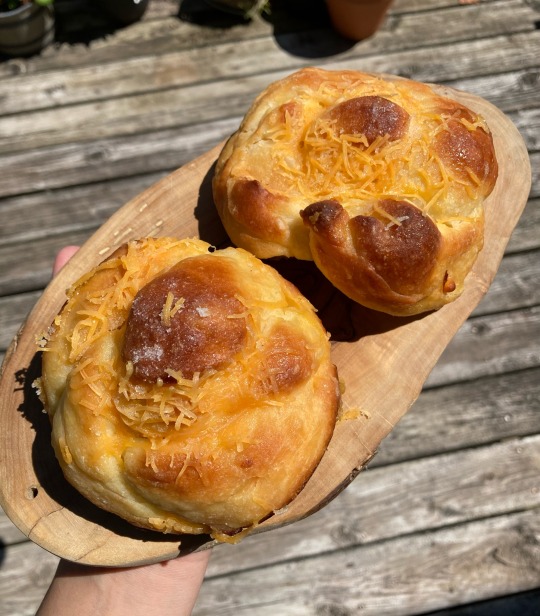

made ensaymada :)
#food#fanciest looking ensaymada i’ve ever made..#this is a new recipe i got it from a book i recently bought#it’s called memories of philippine kitchens. it’s part cookbook and part filipino food history#breadposting#mine
3 notes
·
View notes
Text
0 notes
Text
Proud To Be A Filipino
April 15th, 2024
So when I was in high school, I was not one of the advanced English students, however, I was one of the advanced Math students. My teacher then was Mrs. Ginaline Untiveros. Well, let me think who among my teachers in high school really made an impact on me besides Mrs. Untiveros.
I believe it’s Mrs. Advincula, she’s a Filipino teacher. I can fairly remember the word “Apple”. How to properly pronounce it with an American accent.
She instilled in us the term “colonial mentality”. That we Filipinos believe that we should mimic the lives of Americans, be like them as we were once colonized by Americans way back in the 1900s.
She said we should remain “Filipinos at heart” wherever we may go… whether in the U.S.A., Canada, Australia, United Kingdom, etc.. We are born as Filipinos and we shouldn’t forget our roots and our rich history.
I am a Filipino and very proud to be one!

#Blog#Blogger#Personal Blog#Silence Speaks When Words Can't#Artsy Ally LB#Food For Thought#Proud To Be A Filipino#Know Your History#Be Humble
0 notes
Text
Toasting to Freedom and Flavor with Liberation Lager at Cafe Romulo
In the annals of Philippine history, the name Carlos P. Romulo is etched in golden letters. This journalist, diplomat, and the first Asian to serve as president of the UN General Assembly left an indelible mark on our nation. His legacy endures through the prestigious restaurant chain operated by his descendants, Romulo Café. But this isn’t your ordinary dining experience; it’s a culinary journey…
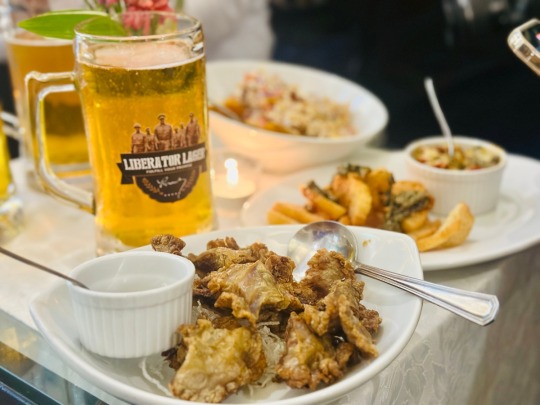
View On WordPress
#Cafe Romulo#Carlos P. Romulo#Carlos P. Romulo legacy#Chicharon Bulaklak#craft beer#cultural experience#Engkanto Brewery#Family recipes#filipino cuisine#Filipino dining#filipino food#Filipino heritage#Food and history#General Douglas MacArthur#gising-gising#Historical photos#Ivy and Cecile Almario#Leyte Landing#Liberator Lager#Lola Virginia#Makati branch#Makati dining#Makati restaurant#Oven Baked Crispy Pata#Philippine culture#Philippine heritage#Philippine history#Pinoy menu#Pinoy Nachos#restaurant review
0 notes
Text
youtube
What Our Utensil Designs Say About Our Culture by Design Theory
When I was little, I got sick of my dad subtly making fun of us every time we went to a Chinese restaurant. He'd ask for chopsticks for himself, then always make sure to chat up with the waiter about how the rest of us didn't know how to use chopsticks or were just not very good at it. -.-;;;;; So after we hosted a big anniversary party for my grandparents, we had an entire freezer full of orange chicken, and I swore I'd use chopsticks everyday, until it ran out. But by then, I had gotten used to using the chopsticks, that I started using them every day, at every meal, every snack, for everything. I told myself I wouldn't stop until I got good at it. That was YEARS ago.
By now, a year or so ago, I finally realized that I don't need to practice anymore. I'm pretty competent at chopsticks, so I should just use whatever utensils I like the best. And I determined that I prefer using a spoon and fork together, in the Filipino style. You know how Westerners chase food around a plate with a fork OR a spoon? Filipinos use the fork to push the food into the spoon. Filipino food has a lot of sauce/broth, and I love getting some sauce/broth with every bite. But also, I eat so much food that isn't always cut into small pieces. And when whole pieces of meats or fish have been in the frig for a day or 2, they don't exactly come out of the microwave, soft enough to separate with chopsticks. With those foods, trying to separate it into smaller chunks with chopsticks, is just asking to fling food around the room, with the forces applied. Sometimes, it's just safer to cut everything up with a spoon and fork, Filipino style, then I bring back out my chopsticks. lol So despite how much I love using chopsticks, I decided, I prefer best, spoon in conjunction with fork, Filipino style.
Otherwise, I still use chopsticks. I love using chopsticks for snacks and finger food. I've used chopsticks for everything from potato chips and popcorn, to yogurt and ice cream. But that was more about my dedication to practicing with chopsticks until I got good. I'd prefer to eat cream desserts with spoons. But unless my hands are slippery from lotion (Curse this pandemic causing me skin problems!), I still find myself eating cakes, pastries, and ANYTHING else with chopsticks. It's just so much more convenient for people like me, who are particular about tempering the flavors of EACH bite of food. I love customizing each bite, very consciously. And if I'm too lazy to use both hands for even the Filipino style of using a spoon and fork, chopsticks are still better.
The video mentioned eating with hands. And I know that Filipinos traditionally eat with hands too---I remember my grandmother eating that way. But I don't think I could eat with my hands. I'm too germaphobic. I'm too uncomfortable with sticky fingers. Oil or cheese dust under my fingernails? Going to drive me up the wall. lol Maybe I'm too hypersensitive, but feeling all that food residue on my fingers, my skin, my fingernails...? Ugh, I don't think I could do it. And I don't think I could ever FEEL my hands would be clean enough. I'd have to wash my hands between each touch of a glass or condiment bottle, before I returned to eating with my hands again. And even then, the stickiness would just feel too gross to me. That's why I use chopsticks for snacks. When people start talking about the joy of licking cheese dust or sauces off their fingers, I just can't relate. lol I don't care if it's called "finger food", I want my chopsticks! ^o^
Kind of surprised this video essay didn't mention forks and spoons replacing personal knives. I can't remember where I heard it, but I remember something about how Medieval(?) people used to always have personal daggers on them, for self defense and whatever utilitarian tasks needed cutting, and those daggers were also used for eating. But people realized that hosting a dinner party was equivalent to inviting a bunch of armed people to your house. So they thought it safer to start having eating utensils. That's why table knives are also blunt. Maybe it was a history video? I remember it mentioning a Byzantine princess marrying into a more westward country and she was kind of looked down on for bringing a set of eating utensils with her, instead of eating with her hands, like everyone else. What was that video...?
#Youtube#eating utensils#food#cultures#asian american#design#comparisons#contrasts#reminicing#filipino#nostalgia#video essays#history#personal preferences
0 notes
Photo
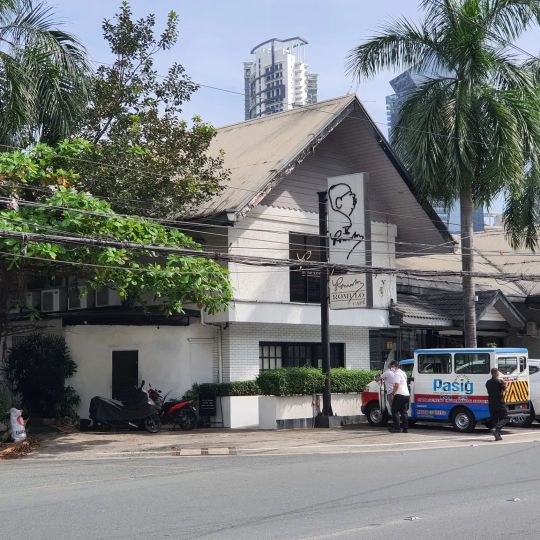
Romulo Cafe offers wonderful Filipino food that is cooked according to time honored traditions that is reflective of the history surrounding the place. Must try for small meetings and events #NewsMediaNest #romulocafe #filipino #food #lunch #buffet #meetings #history #carlosromulo #filipinofood #meetings (at Romulo Café Jupiter St. Bel-Air Village, Makati City) https://www.instagram.com/p/CkgG_htPxT0/?igshid=NGJjMDIxMWI=
0 notes
Text
ride home ! carlos s. x ofc (filipino!content creator!ofc)
“and my weary heart has come to rest in yours.”
summary: carlos sainz accidentally outed himself as a married man and his wife is filipino, which is quite ironic if you would look at the history between the two nations. OR mona magdalena was something of a surprise to the f1 world as she’s something of an… ordinary person. but the ferrari driver’s in love with her and that’s enough for anyone to understand.
content warning: established relationship, use of explicit language, unclear plot (intro to carlos sainz’ ofc wife), fluff, lando = knowing something you don’t, poorly translated comments, mentions cheating (no one did), connected to the alessandro/hearth universe (see masterlist)
note: there will be a translation to some of the words in this post (context: spain colonized philippines for 300 years and language/culture/practices were adapted from spain.)
this is a self-indulgent fic. a little bit of it i think. this came from my halo-halo homies’ asks and i was inspired to write. i should write some fernando alonso soon, no? enjoy xx
masterlist




liked by carlossainzjr, landonorris, zildbenitez
user1 CONGRATS MAMITAAAA
user2 welcome back to philippines magda!!
zildbenitez sex or chocolate? liked by monamagdalena
monamagdalena the city by the 1975
user3 i cant believe that you’re working a regular job in spain/england while you’re a whole ass celebrity in the philippines 😭 liked by monamagdalena
monamagdalena duality of a woman 😉
benandbenmusic gimmick sa’n? where should we hangout?
monamagdalena i want some inasal :)
benandbenmusic bet, meet u at the nearest mang inasal then 🫶
carlossainzjr y u so pretty cariño? liked by monamagdalena

carlossainzjr posted a story !!!

this story in unavailable
[translation: my wife should just quit her day job and come travel with me]

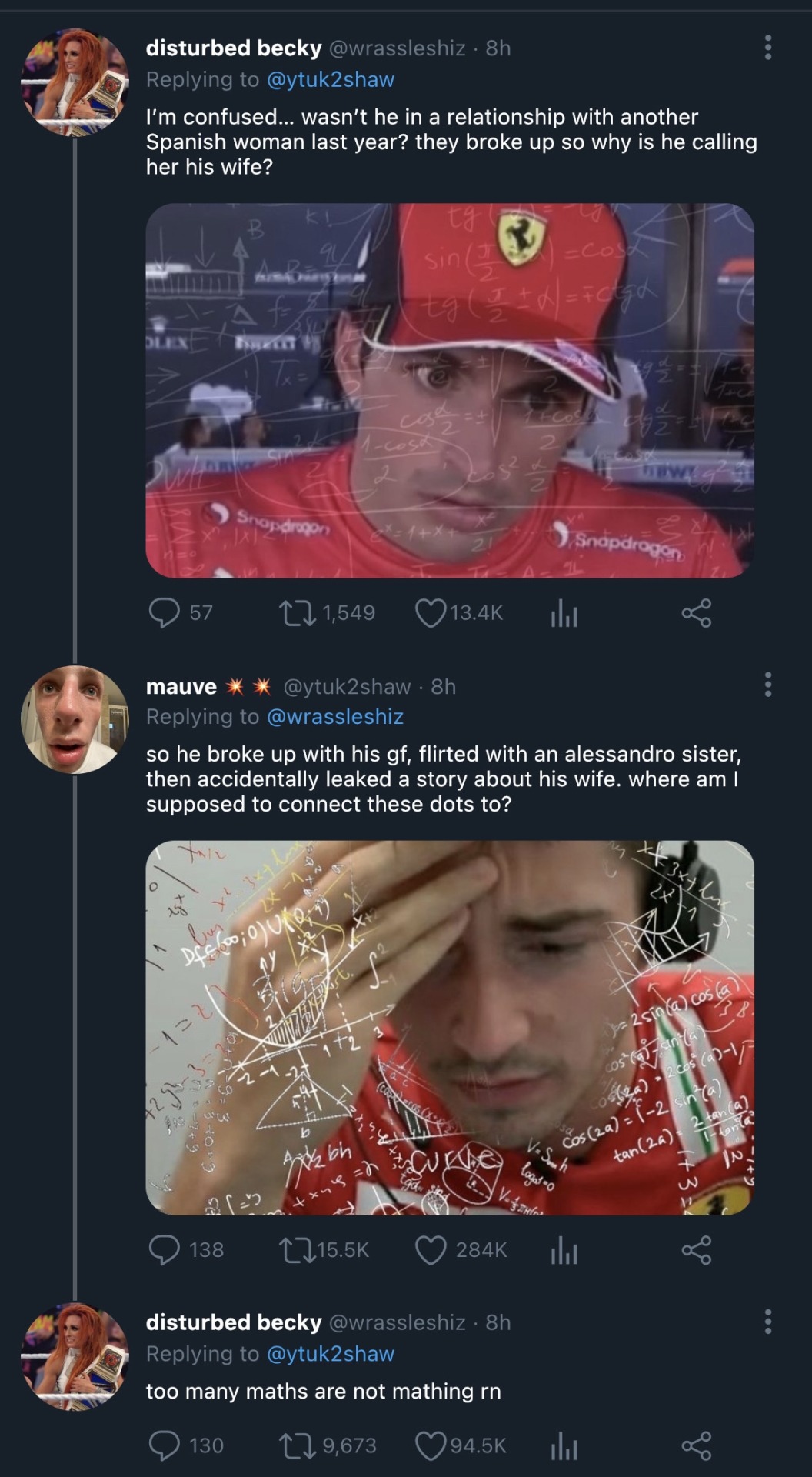






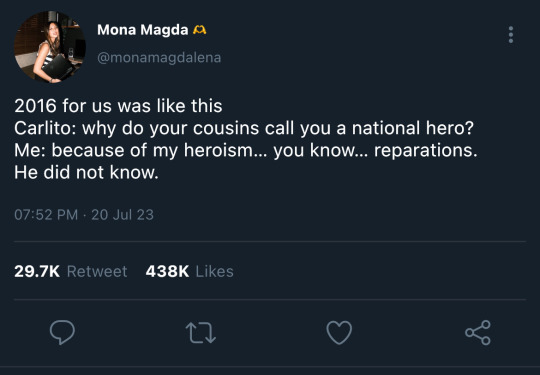





[translation: there’s no one i would yearn for more than you, my lovely lady.]
tagged monamagdalena
liked by charles_leclerc, blastersilonga, landonorris
user1 ok but why doesn’t she give wag vibes? did she ever attend any of his race?
user2 she doesn’t seem to be like his type tbh. why does she have a huge fanbase?
user3 bestie they’re married- what more can they do?
user4 she’s hella gorgeous
user5 i didn’t even know who carlos was until now :’] magda really chose the perfect one 😭
user6 welcome to the pits of hell we call f1. ferrari’s at the deepest depth - carlos drives for ferrari
user7 y’all btches blind if you don’t see the heart eyes carlos is giving her
user8 he’s so in love i wish that were me
landonorris ok but i’m rooting for you two though 🥲 liked by carlossainzjr and monamagdalena
monamagdalena thanks, lando! i’m also rooting for us :)
monamagdalena you’re the best partner to have existed. mahal kita sobraaaaaa ❤️ i love you soooo much liked by carlossainzjr
carlossainzjr see you soon cariño ❤️
user8 she really said “colonizing his heart” 😭
user9 who cooks better though?
carlossainzjr her because she grew up with a single mother only and they always make the best cuisines - lena taught me how to cook most filipino dishes
monamagdalena most filipino dishes that NEED to be paired with rice 🥲 i get so lonely having to eat rice by myself at times
landonorris you should have me over so we can eat rice together
monamagdalena you betcha. i’ll be making you dinner like it’s a filipino birthday party lando!
user10 now THAT is the dream 😩 imagine being so sweet that you’d make your husband’s mate some roast pans full of filipino food and pull up the karaoke ughhh so mother of u


bonus !!!

translation
mahal / irog = terms of endearment, “love”
#formula one fanfiction#formula one fic#formula one imagine#formula one x oc#formula one smau#f1 imagine#f1 fic#carlos sainz x reader#carlos sainz imagine#carlos sainz jr x reader#carlos sainz jr imagine#carlos sainz smau#carlos sainz au#carlos sainz fanfic#carlos sainz fluff#carlos sainz social media au#formula one ig au#formula one instagram au#f1 smau#f1 fanfic#f1 x reader#formula one x reader#formula one social media au#f1 social media au#f1 fluff#f1 fiction
567 notes
·
View notes
Text


𝐖𝐇𝐄𝐍 𝐈𝐍 𝐌𝐀𝐍𝐈𝐋𝐀 with Mikey
Mikey's life in Manila with you ♡
♱ a/n: this is for all the Manila Mikey lovers and Filipino girlies ♡ (belated) Happy birthday to our man ❤️🔥
🦇 @hiraethsdesires @sukunassuka @anahryal @half-baked-biscuit @fuyuluvr @iluvizana @saenora

Mikey sat in his tiny apartment in the heart of Manila, looking at the photograph of his late brother on the wall. He had dreamed of this moment for years, ever since his brother told him of the bustling streets, the delicious food, and the warm, tropical islands of the Philippines, his favorite destination. It had taken time, but Mikey was finally here, living in the place of his brother's dreams. And then, the doorbell rang. It was [ Y / N ], the love of his life. “You look beautiful,” he said to [ Y / N ], smiling as he held open the door for her. “Thank you, Mikey,” she smiled. “You look wonderful yourself.” she blushes, eyeing down Mikey’s simple black pants and camisole outfit; layered with a plain white button-up shirt that exposed his toned shoulders.
They usually plan to have a date around Manila, a city that Mikey had only ever imagined. During jeepney rides with Mikey, he would let [ Y / N ] rest her head on his shoulder and hold her hand the entire ride. And on occasions when the wind blows harshly through her hair, he reaches around her shoulder to hold it for her.
Getting street foods and strolling around the park is a regular occurrence in the relationship. Given that everything that Mikey loves is in it; cheap and delicious food to satisfy his sweet tooth, the town, and you! Mikey’s favorite has to be the pink, frozen dessert, Ice scramble and Turon. And on times when he misses the dorayaki and taiyaki back home, he would just take [ Y / N ] to Mitsukoshi Mall, a big Japan-themed mall in the southern part of the Metro.
But Mikey and [ Y / N ]’s favorite place in the city is Intramuros. While it was now mostly a tourist attraction, there was still a sense of history and beauty in the air. They walked through the ancient walls and narrow streets, passing by old churches and museums, each one with a story to tell. Carriages run by horses still strolled the roads of the historic city, making Mikey ang [ Y / N ] excited to be on a date around Intramuros every time.
The two of them climbed into the classic, horse-drawn Kalesa and settled into their soft, leather seats. The driver smiled and called out a greeting in Tagalog, and the couple greeted back. The Kalesa began to move through the quaint streets of Intramuros, and Mikey and [ Y / N ] watched as the city came to life around them in a unique, old-fashioned way.
Mikey never had a deep interest for the fine arts, but when [ Y / N ] asks to visit the National Museum, he couldn’t pass it up. As they walked through the museum, their hands entwined, they felt the weight of history pressing down on them. It was almost as if they were walking through the pages of a history book, each exhibit a new chapter in the story of this incredible country.
After spending some time exploring the museum, they made their way to Fort Santiago, a historic fortification in the heart of Manila. As they walked through the ancient halls, their footsteps echoing with the weight of history, they knew that they were standing on sacred ground.
As they wound their way through the city, they passed by ancient doorways and carved archways, the scent of incense wafting in the air from the nearby churches, and they made a stop on perhaps the most famous one. As they entered the church, the air grew thicker still with the weight of history. The stained glass windows cast colorful rainbows across the floor, and the faint sounds of prayer and song echoed through the ancient halls.
Mikey and [ Y / N ] found a pew near the back and sat down, hands entwined as they looked around. They marveled at the intricate carvings and the ornate altar, feeling like they were in a different world entirely.
As they sat in the dim light of the cathedral, their hands tightly intertwined as they admired the beautiful architecture and the historic artifacts. Mikey couldn't help but feel a deep sense of love and adoration for her, and he knew that he wanted to spend the rest of his life with her. As they sat there, Mikey leaned in close and whispered in her ear, “I want to marry you here.”
[ Y / N ] stood still, stunned by his sudden confession. But she had always known that Mikey was special, and truly meant what he said. “Mikey,” she whispered back, feeling tears well up in her eyes. “I would love nothing more.”
Mikey and [ Y / N ] return to the Kalesa, watching as the ancient city of Manila passed by. They had had a beautiful day, exploring the National Museum, Fort Santiago, and the San Agustin Church, and now they were ready for one last adventure.
The driver of the Kalesa pulled up to the shores of Manila Bay, and Mikey and [ Y / N ] climbed out, eager to take in the sights and sounds of the ocean. They walked along the coast, watching the waves rock parked yachts and crash against the shore.
The sun was setting, casting a golden glow across the water, and the lights of the city glittered on the horizon. They made their way to the edge of the water, where they found a quiet spot to sit and enjoy the view. They watched as the sun began to sink below the horizon, turning the sky into an endless canvas of red and orange, and the waves crashed against the shore in a steady rhythm.
As they sat there, taking in the beauty of the moment, Mikey leaned in close to [ Y / N ] and whispered, "I want to spend every sunset like this with you. You make me feel like the luckiest man in the world."
[ Y / N ]'s eyes widened in surprise, and she turned to look at Mikey, her heart aching with love and joy. "I feel the same way," she said softly. "I never imagined that I could find love like this, in this place, with you."
As they sat there, hand in hand, surrounded by the beauty of Manila Bay and the magic of the sunset, they knew that they had found something truly special. A love that would last a lifetime, and a lifetime filled with memories of this quaint place that had brought them together.

#tokyo revengers#mikey x reader#manjiro sano#mikey#sano manjiro#sano manjiro x reader#mikey sano#manjiro x reader#manjiro sano x reader#mikey x reader fluff#tokyo revengers fluff
262 notes
·
View notes
Note
Hey bro I like your writing and I was wondering if you could give us some Mizu x Filipino!Reader hcs🥺👉👈 ̶(̶t̶o̶t̶a̶l̶l̶y̶ ̶n̶o̶t̶ ̶g̶o̶n̶n̶a̶ ̶u̶s̶e̶ ̶i̶t̶ ̶t̶o̶ ̶p̶r̶o̶j̶e̶c̶t̶ ̶m̶y̶s̶e̶l̶f̶)̶
I have to make this poetic I'm so sorry but also making it modern!au and canon setting teehee (ALSO DOUBLE UPDATE?) slight nsfw ig!! mdni.

canon divergent, just think of this is as that scene from Goyo where Remedios and Gregorio Pilar do a wholeass pining scene idk
Absolutely met you at some fancy ass noble party
You're a child of a wealthy Senor who's in great partnership with the Lords from the Commonwealth
Mizu's camping in and disguising herself in the party to find more intel on her next target and then she bumps into you
at first you're like very inquisitive of where she came from (considering that you view her as a man at this point), how she enjoys the party and what not
then you're suddenly like ik what you're doing. you're not from here.
Mizu's thrown off bc haha this is an international gathering of sorts and like ppl here are mostly foreign
you're like well its bc you're so obvious when it comes to occasions like this that I've already spotted you from a while back
and so youre like dancing and all and Mizu has no choice but to extract info from you
she reveals that shes looking for a white man, and that he may have connections here in the ph
and coincidence cuz you, who's also a part of the resistance, have been tracing the weapons provider of the spanish army.
so you guys work together. you give her intel, she helps you hunt down the provider and their little goons
it kind of starts like an enemies to lovers .... kind of a forced situation where Mizu has to deal with the resistance in order to get to what she wants but rlly theres no other way around
falls in love w your love for your country
despite your privileged upbringing, you're deeply interconnected with your roots, and have been fighting for the filipino people
you guys fight over the simplest of things, like how she doesnt wear things right or holds weapons correctly
you definitely bond over weaponry though and its history. the first time you've seen her katana, you were so amazed. in return, you showed her a kampilan—a sword carved and forged by your grandfather. she had so many questions.
yeahh overall i think what pulled you together was your shared anger and desperation for justice. No matter the situation, whether it be a resistance against oppression or looking for the man that caused a hellscape within your life, y'all resonated with the emotions and trauma that came with that.
BEST BELIEVE THE SEX WAS GOOD and rough and yes hbejawhejehe mhm
anys thats all. you're like PARA SA PILIPINAS and shes on her knees.

modern au hehe
met through int sch program. mizu is a transferee from japan who joined their uni's international program and got linked w ur sch
she was in one of ur classes and like yeah, she was nearest to u so she had no choice but to ask u for sch stuff
YOU THOUGHT SHE WAS PRETTY CUTE but like u wanted a good impression so u tried to help her as much as u could
even gave her a tour of the campus
showed her a few iconic eating places that she could go to jic her budget was on a limit or wanted good filo food
you wanted to expose her to the culture as slowly as u could just so that she could adapt and pace herself
definitely stuck by your side since then
you learned that she's going to study here for 3 years before going back to japan for her masters, and you're like wow thats so cool and shes like thanks
definitely a gamer
you guys hang out at one of the comp shops nearby (IF NAGAARAL KAYO SA TAFT .... guys suki ako don HAHAHA)
loves learning abt history, esp filipino craftsmanship
you definitely treat her to various street foods
mizu : what's this
you : we call it kwek kwek, but u can call it neon balls
mizu: neon balls????
showed and taught her how public transpo works once, and she gets a hang of it a week later
knows her way around manila than you do (author is projecting mb)
knows basic filo words when navigating. you teach her the slang.
basically friends to lovers guys omg, ayon sana all eme
you do that lips thing where you point w ur lips and at first, she was so confused (this is during your relationship)
she thought you were asking for a kiss and she kissed u and you were like ?!@!?@??$?
mizu: ha
you: I WAS ASKING FOR THE,ASd MUGWTF
mizu: ahhh my bad haha
walks u to class teehee
hangs around in empty class rooms esp comp labs and you guys watch movies there
momol sa dorm, momol sa clasroom na madilim, momol sa may agno charot
MOMOL = MAKE OUT MAKE OUT LANG
revels in simple pda like linking ur pinkies together, thigh against thigh when seating, and just yk so landi. landi niyo.
you have her id pic on the back of ur id and she yours on her clear phonecase
EWWWW GAY PPL (affectionate)
unintentionally matching
loves gifting u jewelry esp necklaces (likes to see it when u guys are in the bedroom, splayed on your chest and just yk decorating your collarbones so nicely)
holds your hand and helps you cross the street omf
pays for ur commute fee when riding the jeepney
memorizes ur kwek kwek and fishball sauce combination
loves exchanging one shoe w u for funsies
loves taking pics w u w the cats on campus
OVERALL A CUTIE TEEHEE!

A/N: DEDICATED KAY DELULU RECEIVER!! eto para sayo sorry ginutom keta ng sobra huhu @ianiralvs may isa pa kong utang sayo na req mo hihi gagawen ko pa yon to muna HHAHHAHA
90 notes
·
View notes
Text
Celebrating Christmas in the Philippines: The Christmas Capital of Asia (Part 2)

A parol shop selling other Christmas decorations posted by yeowatzup (2005) via Wikimedia
This is a second part of a longer post on Christmas in the Philippines. Part 1 can be found here.
(Also I know this is a little late, had some personal stuff this holiday season so sowwyy)
Practices in the Present Day
Christmas traditions today are a mixture of both traditionally Hispanic and American practices with some new and additional modern things added in from the past century. Most of these traditions are still done by a lot of Filipino families today and continue to be icons in Filipino culture.
The Longest Christmas

An image of a calendar posted by Benham Norouzi (2021) via Unsplash
It is well-known that the Philippines starts the Christmas traditions on the 1st of September, making it the earliest start of the any Christmas season in the world. This comes from a lot of factors, primarily because Filipinos love the idea of counting down the 100 days before then (which start at the 16th of September), and was later on used in other settings like when people would put up decorations in their own homes and in businesses encouraging the later commercialized holiday to also start early with sales and other deals (Handong, 2017). This later made it sort of official that Christmas would start on September, earning the season the colloquial name "The Ber Months" or "The Ber Season".
As I said in a previous post, however, actual celebrations often start after undas and more specifically after the start of Advent and more intensely during the start of Simbang Gabi or Misa de Gallo on the 16th of December and you would be hard-pressed to actually find people celebrating before then.
It doesn't stop people from having online count downs with Jose Mari Chan's infamous Christmas song "Christmas in our Hearts" in the background (that had been memed on in the Philippines on the scale of "All I want for Christmas is You" in America) on the 31st of August to midnight to greet the 1st of September though.
24th as the Day of Celebration
Other practices that Filipinos inherited from the Spanish from this time was the practice of mostly celebrating the holiday on the eve of instead of the actual day of the 25th. This comes from an older Roman Catholic tradition of having Christmas mass from night time to the next day based on the traditional belief that Jesus was born on exactly midnight on the 25th (The Pillar, 2021). Celebrations like Christmas Eve dinner (the Noche Buana) and gift giving happen during this time with gift opening happening during the stroke of midnight.
Personal side-note, since I'm not gonna add a final section detailing more personal stuff here because it's getting too long: as a kid, I was always confused at American TV shows that showed people sleeping at night before opening up presents in the morning. It never really registered and I always questioned why they had to wait 'til morning for them to open presents. because of this, the whole Santa Claus thing didn't make sense to me either.
Simbang Gabi

People attending Simbang Gabi captured in St. Anthony de Padua Parish Church, Iriga City, Camarines Sur uploaded by Patpat Nava (2015) via Wikimedia
Similar to most Christian countries from the 16th to the 18th Century, the Philippines celebrated Christmas as a religious holiday focused on prayer and masses, often seen in the form of Simbang Gabi or Misa de Gallo which I had discussed in full detail with its history and current practices here. The basics of it is that Filipinos would celebrate Christmas and the lead-up to the holiday by going to church every day for nine days until the 25th starting on the 16th. The practice was brought over by the Spaniards as it can be seen practiced or some form of it practiced in Spain and a few other Hispanic countries.
Other than just church-going, Simbang Gabi is also famous for its many foods that had come to be strongly tied to the event, mostly rice cakes that are sold outside of churches early in the morning and late at night like Puto Bumbong, Bibingka, Sapin-sapin, and many more.
The Parol or The Star Lantern

A photo of parols displayed on a store credited to Sagisag PH posted by Behold Philippines (2021).
One of the most recognizable symbols of the Filipino Christmas is the star lantern known as parols that often can be seen decorating the houses of Filipinos of all different backgrounds. According to Giselle Tong-Walters of the Association for the Advancement of Filipino American Arts and Culture or FilAm Arts, the parol predates Spanish colonization as precolonial Filipinos would often hang lanterns on their homes at night to tell any traveler that may have seen it that they are welcome to seek refuge there (Dormido, 2023).
Others note that the parol had taken inspiration from the Mexican piñata which had originally come from Spain that had come from Italy some time in the 1300s and was said to have been first used in the Philippines as a light-source to guide people early in the morning during Simbang Gabi which remains the popular origin for the parol today (MyParol, n.d.).
The modern parol is said to have been first created by Kapampangan artist Francisco Estanislao in 1908 by using the traditional five-point design by using Bamboo strips and Japanese paper which was later done with the use of the newly created material cellophane as well as the increased use of electric lights that made the star lanterns that Filipinos are familiar with today (Tapino, 2018).
Today many variants of the lantern exists including more and more complicated designs with even the use of sea shells being fairly common.

Seashell lanterns are also a fairly common sight during the holiday season. Image posted by Tapino via Spot.ph (2018).
The Nativity or Belen Display

Capas Municipality’s 13-meter tall Belen takes on Eiffel Tower as the backdrop for their winning Belen, made of bamboo, recycled materials and decorated with LED lights. Image posted by Christine Dayrit via PhilStar (2018).
Like a lot of religious Christian places or former religious Christian places, the nativity is a common sight during the Christmas season with some families owning their own personal display and communities typically having larger ones in their centers. Some people create more handcrafted versions if they don't have the money to buy their own set and some communities may even hold competitions to see who could make the most creative ones.
Noche Buena

An image of a Filipino Noche Buena spread posted on Lessandra.com (2020)
Just like the Spanish, Filipinos celebrate Christmas with a Christmas feast on noche buena (en. the good night) or Christmas Eve with itself as noche buena instead of referring to it as the dinner on noche buena. This particular naming quirk extends over for New Year's Eve Dinner being called medianoche despite the word simply referring to midnight.
The reason for this may come from the fact that Filipinos had gravitated more to using the literal terms with Bisperas ng Pasko and Bisperas ng Bagong Taon (en. The day/night before Christmas and The day/night before the New Year) which made noche buena and medianoche redundant, later tying them to specifically refer to the dinner, although that's more speculation on my part.
The practice, of course, had come from Spain some time during the 17th Century when it was first exported the empire's colonies through Roman Catholicism (Paz, 2022). The dinner was marked with lots of food and may include multiple families eating together.
Typical food found during Noche Buena include the hamon (glazed ham), lechon (roasted pig), lumpia (spring rolls), leche flan (milk flan), graham cake, and queso de bola (a special cheese ball), among many other foods. These food are also the same or similar food that are served during medianoche or New Year's Eve Dinner.
Gift-giving and the aguinaldo or the pamasko

Photo of people giving each other gifts posted in an article by Lumina Homes (2020)
Gift giving is often done on the 24th, typically after either Christmas Eve mass or Noche Buena. Most families would wait until midnight as the date goes to the 25th in order to open presents with the typical Christmas gift giving flair.
Besides the gifts themselves, it's tradition for godparents to give money to their godchildren in red packets we call ampao, with this being called the aguinaldo or the pamasko. The practice originated from Chinese-Filipino communities who would often do this for Chinese New Year's which later spread to non-Chinese communities who instead would give the red envelopes during Christmas (Ki, 2019). Although some may think that the money giving stops after adulthood, some godparents
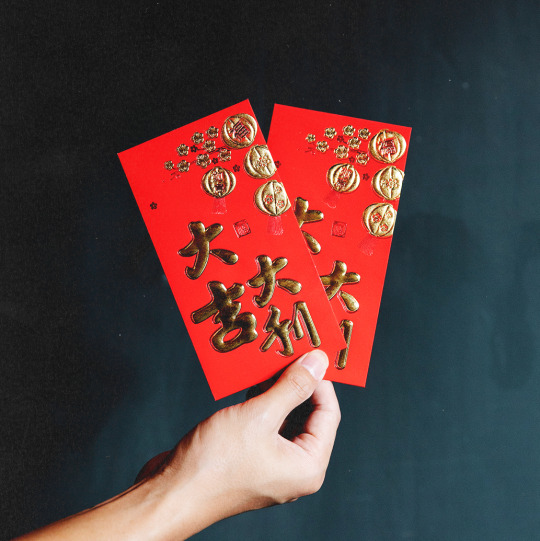
Two Red Hang Bao or Ampao typically given during Chinese New Year posted by Mikhaila Archer via Cosmopolitan (2022).
Christmas Caroling
youtube
Video of children caroling posted by Rauselle Pascua (2023) via YouTube
Christmas Caroling in the Philippines typically start at the beginning of the Simbang Gabi and ends on the 24th, with some caroling much earlier, where children to full adult groups may go door to door to carol for candy, food, or money. Children often go in groups and sing the typical Filipino Christmas songs with makeshift instruments such as tambourines made out of cans and small metal bits to make sounds, while teenagers and adult groups may go around from house to house with guitars and other portable instruments in order to receive cash.
The songs that they sing may range from traditional Filipino songs or modern Christmas songs from both local and international places.
I don't have a source for this one since I do want to look more into the history of Christmas Caroling in the Philippines maybe next year so enjoy this other video of a group of guys dancing Jingle Bells posted by SG TV (2019).
youtube
Side Story: I used to spend Christmas with my, honestly, wealthier grandmother and it wasn't uncommon for carolers to go up our door and just sing for candy or money. It often started on the 16th because caroling wasn't allowed any time before that. We used to have a weird little rule that children would get candy, while teenagers and adults will get money. Teenage boys would come around as whole groups with guitars and sing for money, while kids didn't mind the candy. After a while, there would be times that different people in the house would give candy away so we weren't able to keep track of which kid had already gone to our house. It wasn't until one of the people who worked for my grandma recognized a couple of kids that we realized that they've just been going around the neighborhood before doing another round when people may had already forgotten them. Honestly, I'm a little impressed.
Panunuluyan

Photo of a Panunuluyan posted by Philippines Tourism (@/MorefunTourism) (2018) via Twitter/X
The Panunuluyan is a traditional play that reenacts the night of Jesus' birth where Mary and Joseph were trying to seek shelter (NCCA Official, 2015). The name comes from the Filipino word tuloy which although typically mean "to continue" is used in this context to mean "to allow in" or "to enter in" referring to guests or visitors entering someone's home. Schools and churches typically do this play as part of their Christmas festivities but it isn't as common as it was in the past (Tan, 2016).
Panunuluyan is also called by different names such as Panawagan (en. announcement) in Cavite and Batangas, Kagharong in the Bikol region, and daigon, pakaon, and patores in Visayan speaking regions (NCCA Official, 2015).
Side story: I had a queer classmate who played Mary in one of these plays against their will in a seminary house production because their mom just said so and the place didn't had any afab people (because seminary house obv), and they ended up falling in love with the guy who played Joseph, serving as the only male crush they have ever had. Hilariously, on a seminary boy meaning a dude who wants to be a priest. I feel bad for them...
The Feast of the Three Kings

A photo of the reenactment of the Epiphany story in Gasan, Marinduque showing the three magi meeting with King Herod. Photo posted by Eli J. Obligacion (2011) via the blog Marinduque Rising.
Observed every 6th of January, the Epiphany or the Feast of the Three Kings is a religious observation that marks the formal end of the Christmas season in the Philippines. In the current day, most communities simply go to church to celebrate the epiphany, it was once a common practice to have a large celebration during the day which involves three people dressed up as the three kings, riding horses to the local church, distributing gifts to the townspeople. This practice is still done in some communities in the country today (Primer, 2021).
From photos I've seen of some of the festivities, two members of the three may put on blackface and/or redface to symbolize all three magis who are typically shown as having different skin tones as seen in the previously linked article from Primer, although some places instead have children play the parts of the magi without any blackface or redface.
Closing
As a kid, Christmas has always been special to me and now that I'm older, it's gotten a lot less cheery as all young adults may feel with the season getting less about joy and presents and more about either work and expenses. That sorta happened here when I was initially rushing this even when I was not in the mental headspace for it so taking a break was almost mandatory. I definitely feel a little bummed that I wasn't able to finish this the day of, but I can't really change it as much.
To those finishing my late extremely long-ass infodump about Christmas in the Philippines, thank you so much for reading and have a Happy New Year!
(Part 1: Etymology and History)
(Reference List)
#mayaposts#mayapino#filipino#philippines#culture#filipino culture#christmas#filipino christmas#history#filipino history#traditions#christmas traditions#filipino christmas traditions#colonial history#spanish colonial history#food#long post
5 notes
·
View notes
Text

Ok as a Filipino I HAVE to give it up to Kuang on this very interesting detail on the Tagalog Grammatica. As far as I know, in my very limited history, Japan, China, and Korea weren’t as influenced by the West prior the 20th Century due to their distrust with Westerners/outsiders to the point their borders had to be forcibly opened by either Western forces or by one another (a gross oversimplification—forgive me or educate me where you can).
However, the Philippines was colonized in the 1500s by the Spanish—the country’s own name is derived from Philip II of Spain—and they didn’t leave until 1898, when they sold us to the US. So Spanish influence is deeply ingrained in our art, music, food, and most evidently, language.
However, unlike English, the Spanish language didn’t exterminate native languages as well as it could’ve. My great-grandparents would’ve spoken Spanish AND Tagalog, and a couple of other native dialects besides. Yes, the Spaniards taught (usually wealthy, usually mixed) Filipinos their language, but Spanish friars utilized our language to their own advantage to better spread the word of God to us “savages”… and also because it was unfeasible to teach so many people who spoke so many languages Spanish. So, they learned one of our most spoken languages to better win us over, to colonize us, to “enlighten” us with their civility.
It would make complete and total devastating sense that these Spanish/European scholars can translate so much of our native canon and oral or written myth and commit it to their own languages. And it makes so much sense Kuang flecks that detail there, in a book that mentions time and time again the silent but sinister undercurrent of imperialism and colonialism in everyday British life in the 19th Century and academia today. I am frothing in the mouth. I am banging my head against the wall. So much history behind one tiny fucking detail.
#rf kuang#r.f. kuang#babel an arcane history#babel rf kuang#is this what white literature/history nerds feel like when reading caucasian-centric academia novels#They feel like they’re part of an in-joke or understanding or niche reference#if so THATS WHAT I FEEL#One other example was about the jane austen thing
332 notes
·
View notes
Text
Enha hyungs with filo!reader
summary: meeting the fam and visiting the philippines with your lovely boyfriend!
a/n: this is VERY self indulgent yall. im filo-american
i think its fully gn!reader.. let me know of any mistakes!
Heeseung
All da titas LUV hee
Girl atp during your family parties
You enter and ur man isnt with you
“Anako where is your boyfriend”
Like damn my bad tita i thought you wanted to see me more
Yk… your niece/nephew
The younger kids love him
Hes the life of the party
This goes without saying but you teach him a lot of tagalog
Or whatever dialect you speak!
You taught him putangina mo and he hasnt stopped saying it since omg
“Yo jake”
“Hmm?”
“Putang ina mo”
LOLLLLL
You teach him how to make your favorite meals
I think heeseung would really enjoy bibingka
Though let me just say
Good luck getting your man back during a party fr like
If hes not doing karaoke w the titas, hes playing mahjong with the uncles, if not them your older cousins steal him to game and the young kids love playing house with him
And once you found him with one of your cousins babies in the room as he sings them to sleep
like which one gave him that baby please..
Jay
Okay so jay
When you brought him to the philippines for the first time
Pookie LIVED at the mall of asia let me tell you
Like honey we still gotta do everything else
Jay would love baguio too
Doesnt even care if they are over paying him for the taho he LOVES IT
“Jay pls stop talking to them in english theyre overcharging u”
“Womp womp i dont care this street food is fire”
Did he fr just womp womp you…
He said this after getting said taho
You made sure he knew how to bless the elderly before you meet everyone
And he makes sure he does it to all the lolas and lolos in your family!
Hes just in awe with the country and how pretty it is
He asks your parent how to cook some of your fav dishes
Just so he can make it at home whenever you feel homesick
He actually had to buy a THIRD luggage for yall cus he would not stop buying souvenirs and clothes when you went.
I think jays fav filo dish would be balatong idk
I dont make the rules
Tbh i kinda do
Anywho
After the trip jay has a talk with you
He really wants to have a house there for whenever you visit and have it be next to your family home :( so cute
Makes plans to propose at your favorite place in the ph!!
Jake
Ok jake
The titos LOVE jake
Honorary filipino of the family fs
Your younger girl cousins are all over him HELP
“Can i have my man back”
“No.”
“You heard them y/n, i guess i have to stay with her”
Oh hes sick
Constantly offered your lola to help cook
She said no plenty of times but he wouldnt take no for an answer!
You took him to visit paoay
LOVED IT THERE
Jollibees number one fan
LIVES for the pineapple quencher got it anytime he ordered
Hesitant on the cheese and ube pie
Ended up buying like two during the visits
Jake love love loves igado
Its now one of his favorite dishes
His fav dish tho was the empanadas by the small shop near your house
After the trip he is now officially in the gc u nd ur cousins have
He was already planning your next trip back
Even though youre halfway through this one
Like babe let's maybe finish this before anything else ok?
Sunghoon
Since hes a bit on the quieter side
Hed be a bit awkward meeting everyone first
If you're in a filo family yk how they are when you bring a man home oml..
But in the end
He fits in well with your family fr
Also hot take
I think sunghoon loves balut
I cant remember if any of the enha members have tried it before so forgive me
But i just feel he woul enjoy it the most
Loved the beach trips you and him would take
He buys the silly “I love the Philippines” shirts
Gets a few little trinkets to display around the house
Became friends with your tourist guide
Now they follow each other on facebook
Based off true events
Talkative s/o and bf who listens
You tell him all about the history of the places you visit
And he looks at you absorbing all the info you tell him
#enhypen#enha#enha x reader#enhypen imagines#enha imagines#heeseung#jay park#park jongseong#jake sim#sim jaeyun#park sunghoon#heeseung x reader#jay park x reader#jake sim x reader#sunghoon x reader#enhypen reactions#enhypen x reader
67 notes
·
View notes